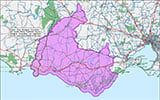Stanhope Bay
![]() Reef Dive |
Reef Dive | ![]() Shore access
Shore access
![]()
![]()
![]()
Depth: 1 m (3.28 ft) to 10 m (33 ft)
Level: Open Water and beyond.
Stanhope Bay is an almost circular bay, with a 200 metre wide opening to the sea and a curving, 250 metre long beach inside. The narrow beach lies at the base of the cliffs and is fronted by a shallow sand and reef bay floor. Waves are low in the bay, with the water often calm at low tide.
Stanhope Bay lies on the Shipwreck Coast of Victoria and is part of the Bay of Islands Coastal Park which continues on from the Port Campbell National Park at Peterborough and extends through to Warrnambool.
There is plenty of interesting structure to explore and marine life to see at Stanhope Bay.
Stanhope Bay is best dived at high tide. See WillyWeather (Stanhope Bay) as a guide for the tide times and the height of the tide.
{{southern-ocean-warning}}Traditional Owners — This dive site is in the traditional Country of the Eastern Maar people of south-western Victoria between the Shaw and Eumerella Rivers and from Yambuk in the south to beyond Lake Linlithgow in the north. This truly ancient Country extends as far north as Ararat and encompasses the coastal townships of Port Fairy in the west, Warrnambool, Peterborough, Port Campbell, Apollo Bay, Lorne, and Airies Inlet in the east, including the Great Ocean Road area. It also stretches 100 metres out to sea from low tide and therefore includes the iconic Twelve Apostles. "Eastern Maar" is a name adopted by the people who identify as Maar, Eastern Gunditjmara, Tjap Wurrung, Peek Whurrong, Kirrae Whurrung, Kuurn Kopan Noot and/or Yarro waetch (Tooram Tribe) amongst others. We wish to acknowledge the Eastern Maar as Traditional Owners. We pay respect to their Ancestors and their Elders, past, present and emerging.
Stanhope Bay Location Map
Latitude: 38° 30.161′ S (38.502679° S / 38° 30′ 9.64″ S)
Longitude: 142° 41.731′ E (142.695509° E / 142° 41′ 43.83″ E)
Datum: WGS84 |
Google Map
| Get directions
Added: 2021-06-04 15:06:00 GMT, Last updated: 2022-05-23 19:28:16 GMT
Source: Google Earth
Nearest Neighbour: Murnanes Bay, 2,149 m, bearing 309°, NW
Shipwreck Coast.
Depth: 1 to 10 m.
[ Top ]
DISCLAIMER: No claim is made by The Scuba Doctor as to the accuracy of the dive site coordinates listed here. Should anyone decide to use these GPS marks to locate and dive on a site, they do so entirely at their own risk. Always verify against other sources.
The marks come from numerous sources including commercial operators, independent dive clubs, reference works, and active divers. Some are known to be accurate, while others may not be. Some GPS marks may even have come from maps using the AGD66 datum, and thus may need be converted to the WGS84 datum. To distinguish between the possible accuracy of the dive site marks, we've tried to give each mark a source of GPS, Google Earth, or unknown.


